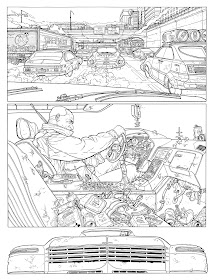
The technical vulnerabilities that the style risks exposing, while significant, are nothing when compared to the manner in which "ligne claire" reveals any deficiencies of investigation or any disconnect between narrative elements and an underlying metaphor. The approach's success only reaches its full potential when an artist possesses the capacity to do both.
Geof Darrow’s work is a truly exceptional example of “ligne claire” in ‘sequential art’, because of the way that his artwork utilizes “linge claire” in a manner that speaks to the time in which we find ourselves living. Darrow’s ability to use this visual language to create a unique voice is largely the result of his inherent authenticity as an artist. Through his work, Darrow is able to accentuate the radiance of the ‘commonplace’ and, very often, the banality of the ‘sacred’.


Darrow’s art displays a profound sensitivity to our modern surroundings, and how overwhelmingly complicated they have become. The visual quality of his artwork acknowledges the relentless nature of modern life and its constant bombardment of sensory stimuli. It is intellectually lazy to classify the complexity and density, present in some of Darrow’s storytelling imagery, as a shortcoming because it fails to abide by the modern belief in the sanctity of simplicity. Darrow’s ability to share his observations and idiosyncrasies, as well as his ability to conjure modern visual metaphors, allow his “ligne claire” work to transcend the twentieth century ideal of paternalism and formula at the expense of nuance and investigation.
While “ligne claire” master Hergé’s art and its ongoing significance, are both a source of celebration and lamentation, what is often overlooked is that his art’s value, as an essential touchstone for us today, is based largely on it being a portrait of the time and place in which it was created. Unfortunately, the popularity and influence of Hergé’s work has inadvertently codified “ligne claire”, as a method, and tethered it to Hergé’s voice as an artist. It is the work of Geof Darrow that has begun to liberate “ligne claire” through the international influences that inform his work, and his ability to examine the cultural landscape as it transitions into the twenty-first century.
It is fascinating to view Hergé’s work and his vision of the twentieth century, today. One can see how its simplicity can be a soothing respite from the twenty-first century and its many complexities(both visual and literal), and it is almost certain that this simplicity was equally soothing to an audience experiencing the horrors of the twentieth. It is similarly soothing for aspiring 'sequential artists' to adopt Hergé's established style and avoid the decades of struggle it took for Hergé to arrive at it.
What Darrow offers us now, is a much-needed affirmation of how our surroundings have changed in the age of industrialism. Darrow’s work allows us to examine a visual landscape teeming with mass-produced, complicated, and instantly disposable packaging and products, that(were they handmade) would surely provoke us to examine them. As Darrow creates visual facsimiles of them by hand, he enriches these objects and calls our attention to them.
The sum of these qualities make Geof Darrow the heir to “ligne claire”. His most compelling work yet is his ongoing series, “The Shaolin Cowboy”. Its trans-genre stream of consciousness narrative, creates mythic imagery inspired by everything from Shintaro Katsu’s “Zatoichi” to Sergio Leone’s Westerns.
The sum of these qualities make Geof Darrow the heir to “ligne claire”. His most compelling work yet is his ongoing series, “The Shaolin Cowboy”. Its trans-genre stream of consciousness narrative, creates mythic imagery inspired by everything from Shintaro Katsu’s “Zatoichi” to Sergio Leone’s Westerns.

If one is interested in exploring the relationship between Hergé's and Geof Darrow's work further, it might be helpful to begin by comparing "Les Adventures de Tintin" and "The Shaolin Cowboy". In particular, noting that both artists include a similar white animal sidekick that seems to always be a step ahead of the protagonist, and the different manner in which the two artists have used sharks as a metaphor in their stories.



